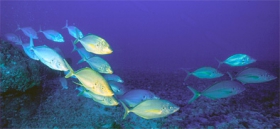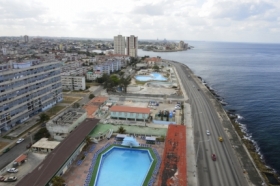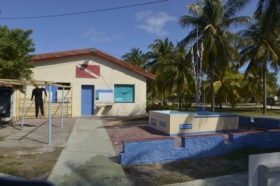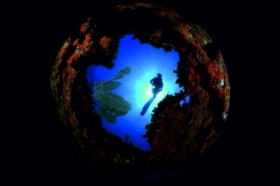Spain and Italy dominated the 14th World Championship in Cuba
Cuba ranks a remarkable fourth place in the world ranking. Excellent results were achieved in the fish category. Read the report of Juergen Warnecke, president of the VISUAL COMMISSION.
(from left to right: Stefano Proakis/Italy, David Barrio/Spain, Michele Davino/Italy)
14th World Championships of Underwater Photography 2013 Cuba -Cayo Largo from 8th to 14th of April
Participating nations:
| - Argentina | - France | - Norway |
| - Belgium | - Germany | - Portugal |
| - Brazil | - Italy | - Spain |
| - Cuba | - Korea | - Slovenia |
| - Croatia | - Mexico | - Sweden |
| - Denmark | - Netherlands | - Turkey |
CMAS delegate:
Lasse Gustafsson /Sweden
CMAS int. judge:
Eduardo Centelles /Spain
CMAS Visual Commission:
Juergen Warnecke
Jury members:
President Juergen Warnecke /Germany
Member Eduardo Centelles /Spain
Member Domenico Russo /Italy
Member Jan Azier /Netherlands
Member Carlos Fonseca /Argentina
Member Sergio Massaro /Cuba
A considerable amount of organization was needed for this World Championship in order to substitute the lack of proper infrastructure. Those who have previously travelled in Cuba are aware of the fact that the country does not meet all the international standards of tourism. Nevertheless, this World Championship proved to be a very special event, an unforgettable experience in the best sense of the word.
When travelling to Cuba, choosing to visit the touristically better opened islands like Cayo Largo (in the south of Cuba) is a good idea, as they offer an attractive alternative to the tourism resorts of Varadero.
The hospitable locals with a lot of music and rhythm in their blood emit an atmosphere, which is characterized by a lot of ease and a joy of living. The music is the elixir of life for the Cubans. Hot salsa music oozes from the inner courtyards of the houses in Havana and everywhere else. The people on the streets instinctively move in sync with the rhythm with a smile on their face, even if they are simply passing by.
Even if the quality of life is not high due to a lack of money, this doesn’t stop the people from living a fulfilling life. As every peso / CUC is needed urgently for a little luxury, no tourist will be addressed without offering a service at the same time.
We experienced Cuba with his unique plants and flowers as an island with an amazingly diverse landscape, along with the open-mindedness of the Cubans and the warmth with which they treat their guests.
The World Championships were organized using modest means but in a seamless manner nevertheless. A sort of prepossession was sometimes noticeable but in the end turned out to be groundless.
The on site cooperation with the CMAS can be described as excellent. The preliminary work lasting about a year proved to be very valuable. There were absolutely no examples of single-handedness; all decisions were made on time and to the satisfaction of all. Fact: This World Championship was a great success.
Juergen Warnecke flew to Havana on the 5th of April in order to begin his work on the 6th of April, three days before the official opening. Supported by the Cuban Diving Association (FCAS), all necessary inspections of the scheduled competition and venues begun immediately.
Here one must also emphasize the preparations of Mintur (ministry of tourism) and Havanatur who organized everything showing excellent skills as well as decision makers and as financial managers.
Most of the national teams had already arrived and had started with their training dives. The underwater conditions were good, the visibility went down to 15 meters and there was no problem with the variety of fish found in the area. All underwater beings could be observed whether using a close-up or a wide-angle lens with a diversity of themes and motifs.
The opening ceremony at the pool of Playa Blanca Hotel took off with a wonderful parade of the nations and was officially opened by the CMAS delegate Lasse Gustafsson/Sweden following a few speeches given by a number of VIP guests. The gala dinner took place in a similar manner.
A technical meeting was held in the restaurant of the hotel in the afternoon of the 9th of April. The categories, as well as all organization formalities were discussed in detail in the course of the meeting.
It became questionable from time to time whether these very emotionally heated discussions were necessary, as all questions had already been answered long ago in the rules (General and Specific Rules), which anyone can read. Even the categories were not always properly implemented, so 6 pictures had to be disqualified because of unapproved motifs.
The CMAS should maintain its traditions in order to avoid such mistakes. Moreover, all questions and discussions contain certain useful points, which help us in executing a better organization.
The Adapting Day on the 10th of April was also the last training day and demonstrated once more excellent preparation works. All buses left on time from the hotel to the competition’s place so as to avoid any kind of chaos around the boats at the marina. All teams were in an excellent mood and encouraged themselves or tried to impress the other boats by singing battle chants. It was a beautiful demonstration of friendship as the boats sailed out to the dive sites.
The first day of competition, the 11th of April, started in a much quieter manner. All 18 teams were focused on their task and tried to get through the checks and registration as quickly as possible. Registration means opening the camera housing in front of an inspector, as well as removing and formatting the memory card. An abstract date was to be set and the face of the controller had to be photographed as a first shot. Following this, everyone went to their assigned boats and the actual process of searching for the best photographer in the world could finally be started. Fortunately, all teams managed to handle this somewhat stressful situation with great composure as they drove towards the sun, the majority of them happily singing.
The next day, April 12th was about improving the previously shot material. Almost all teams were keen to improve their results. The tension between the teams was almost palpable, discussions were held everywhere.
Upon arriving at the marina after the last dive, similarly to the day before, all images had to be stored on the computers of the FCAS, to then begin the great task of the presentation of the photos at the hotel.
The 13th of April, the jury’s day brought good luck and success to all of the teams. Unfortunately the private jury had to start with a three-hour delay, as some teams had significant problems with the presentation of their own pictures and the organizers had to devote some of their valuable time in order to arrange for technical assistance. The 6 jurors considered all of the submitted pictures and reduced their number to ten pictures in every category in the form of a secret voting. Thus a top ten list for each category was created, which was necessary for the public judging.
The delays in the morning became unpleasantly apparent in the evening, as the technology in the old castle could not be tested in advance. Although the patience of the participants and organizers was considerably strained, everything came together after a while and the jurors determined a new order of the first 10 pictures of every category.
As usual, the decisions were loudly commented by the participants and the audience, as well as often applauded appreciatively.
The participating photos in the "fish" category were brilliant. Beautiful pictures were taken, reflecting the diversity of species and their variety.
The "close up" category offered some especially beautiful work, characterised by creativity in the implementation of ideas.
The "close up with theme" category showed surprising results portraying the forms and colours of sponges. Here the colours of many species have been worked out so that the sponge was highlighted as the main subject in the biotope.
In the "wide angle" category fewer really exceptional motifs were to be judged. Once again it shows how difficult it is to meet the required criteria. In this category the underwater landscape should be presented in all its beauty. The photographers often limited themselves to cuttings without considering the classical representation rules and showed plant groups as individual motifs.
The "wide angle with diver" category proved to be a very interesting one. Fisheye motifs dominated the first ranks, but often pushed the actual realistic representation of the diver in the landscape into an abstract dimension.
After the jury came to a final decision, the first three winners were honoured and awarded with plaques of the CMAS VISUAL COMMISSION. The tension was at its peak as t it was not yet clear who would rank where in the world champion positions.
We then went back from the Castle to the hotel Playa Blanca with several buses, where the ceremony for the winner, the final-gala-dinner and the "closing ceremony" were being prepared.
When David Barrio/Spain was called as world champion (winner of the gold medal), the Spanish team was thrilled and cheered at the probably unexpected victory of the winsome photographer.
The Italians Stefano Proakis (winner of the silver medal) and Michele Davino (winner of the bronze medal) were also very happy and visibly moved, probably due to their amazing double success.
The fourth place went to Daniel G. Pérez Hernández, from the Cuban home team.
The rest of the rankings can be found in the appendix.
After the "Closing Ceremony", led by Lasse Gustafsson / Sweden as a CMAS delegate and the handing over of the CMAS flag to the organizer of the 15th World Championships in Holland, the celebration carried on until the morning. The Cubans arranged for wonderful dance acts in which many participants took part, greatly enjoying the dynamic salsa rhythms.
This World Championship was a great success for the CMAS and for the organizers of the FCAS. It shows that even small federations can plan and perform a successful event, when the water and the infrastructure equally stand on their side.

































